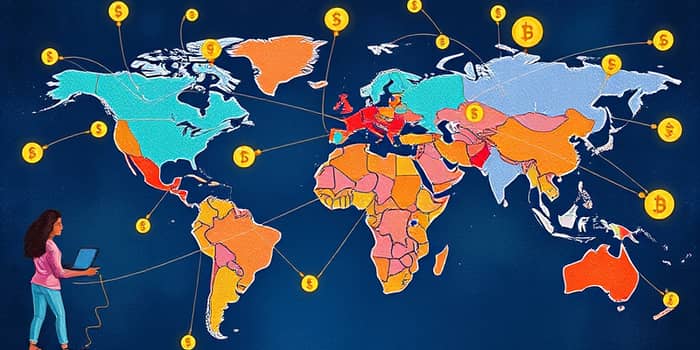
Decentralized Finance, or DeFi, is redefining the way we access and use financial services. By removing centralized intermediaries, DeFi platforms empower users worldwide, fostering an era of unprecedented innovation and inclusion.
Over the past decade, DeFi has transitioned from an experimental concept to a transformative global inclusion movement. Industry reports estimate the DeFi market size reached between $26.94 billion and $44.79 billion in 2025, reflecting an impressive surge in adoption and capital inflows.
Analysts project further expansion to nearly $231.19 billion by 2030, with long-term forecasts envisioning up to $2.02 trillion by 2035. Such projections underscore a compound annual growth rate (CAGR) ranging from 43% to over 50% during the next decade.
In parallel, Total Value Locked (TVL) across DeFi protocols hit $123.6 billion globally in 2025, up 41% year-over-year, highlighting the rapid inflow of liquidity.
The DeFi ecosystem thrives on core segments that attract diverse participants—from retail users to institutional investors. Leading categories include:
Among stablecoins, USDC dominates lending and DEX penetration at 92%, while DAI’s $8.4 billion supply underpins a broad array of protocols. Tether (USDT) remains heavily utilized on alternative chains such as BNB and Tron.
DeFi’s borderless nature allows anyone with internet access and a crypto wallet to participate, reducing reliance on traditional banks. North America holds up to 36% of the market share, driven by a robust fintech landscape and regulatory clarity in the U.S.
The Asia-Pacific region, however, is the fastest-growing market, led by financial inclusion initiatives in China, India, and Southeast Asian nations. Latin America—particularly Brazil and Mexico—also emerges as a hotbed for DeFi adoption, where inflation and banking access issues fuel interest.
By addressing the needs of the 1.7 billion unbanked globally, DeFi platforms offer solutions ranging from microloans to cross-border payments, empowering individuals and small businesses in underserved communities.
At the heart of DeFi are groundbreaking technologies that drive efficiency, transparency, and cost reduction. Core innovations include:
Additionally, synthetic asset platforms tokenize commodities and equities, creating a $3.2 billion market in 2025. Yield optimization protocols leverage automated strategies to maximize returns, attracting value-hungry investors.
Institutional players are increasingly drawn to DeFi’s promise of ultra-efficient capital markets. Major financial institutions and asset managers are exploring custody solutions, DeFi lending desks, and tokenization pilots, bringing fresh liquidity and credibility.
Regulatory bodies worldwide are responding with pilot programs and frameworks aimed at balancing innovation with consumer protection. While uncertainty remains a challenge, emerging standards are paving the way for broader institutional on-ramps and clearer compliance pathways.
Despite its meteoric rise, DeFi faces significant hurdles. Security vulnerabilities—such as smart contract exploits and flash loan attacks—have led to billions in losses, undermining user confidence.
Regulatory ambiguity persists, with varied approaches across jurisdictions. Cross-border development may be hindered by tariffs and licensing barriers affecting oracle services and interoperability technologies, particularly between the U.S., Europe, and Asia.
Moreover, user growth peaked around 8 million active participants in late 2021 and dipped in subsequent years, influenced by market cycles, security scares, and shifting sentiment.
Looking forward, DeFi’s potential remains vast. As protocols enhance security through audits and decentralized governance, and layer 2 networks achieve mainstream adoption, the ecosystem is poised for another wave of growth.
Emerging markets represent a major opportunity. With nearly half of the world’s population still underbanked, DeFi solutions tailored to local needs—like mobile-first lending and remittance platforms—could catalyze financial empowerment.
By 2035, with projections nearing $2 trillion and institutional adoption solidifying, DeFi stands ready to challenge and complement traditional finance. Through cutting-edge blockchain tech and user-centric design, the DeFi revolution promises to usher in an era of equitable, global financial access.
As innovators, regulators, and end users collaborate, the journey toward a truly decentralized financial future gains momentum. In this unfolding narrative, DeFi is not just an alternative; it is a powerful catalyst reshaping the very foundations of global finance.
References













